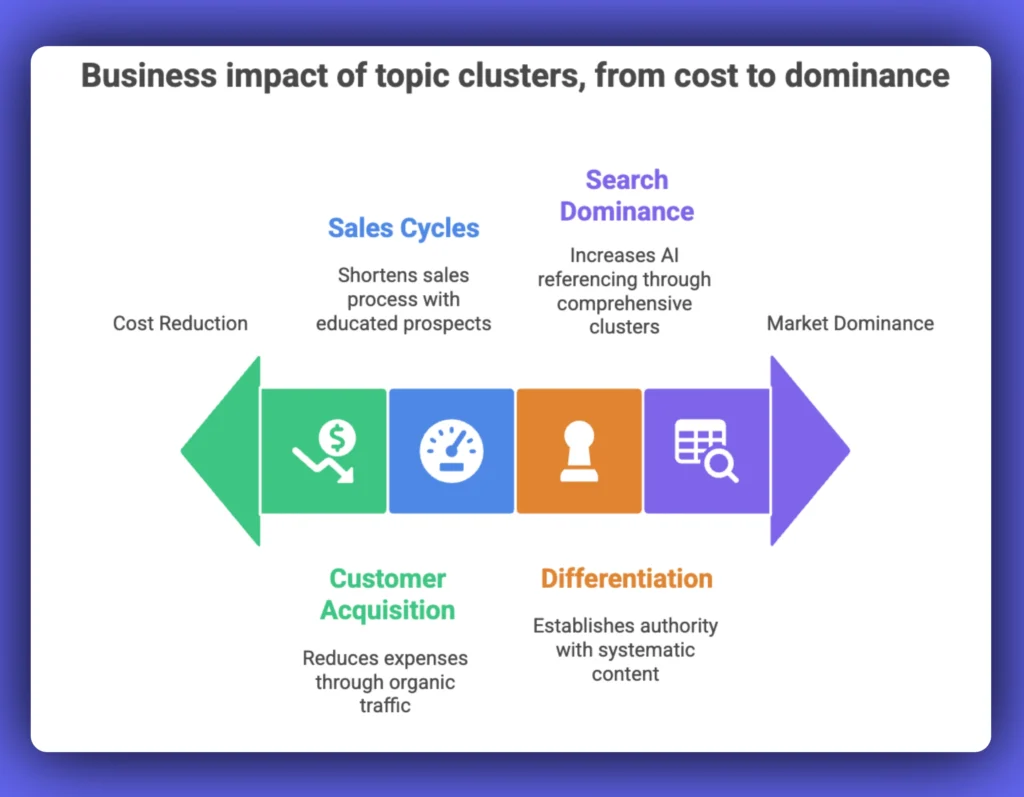Topic clusters are groups of interlinked content pages organized around a central theme, with one main pillar page serving as the authoritative hub. This content architecture strategy helps search engines and AI models like ChatGPT, understand that your site comprehensively covers specific topics, building the topical authority that drives organic traffic and lowers customer acquisition costs for growing startups.
Think of topic clusters as your content’s organizational system that makes both humans and search bots say, “These people really know what they’re talking about.”
The Problem with Random Content Creation
Most content teams operate like they’re throwing spaghetti at the wall. They publish individual blog posts targeting different keywords without any connecting strategy. The result? Fragmented authority that never builds momentum.
The topic cluster model is an SEO strategy centered on building authority for topics rather than ranking for keywords. Instead of competing for individual search terms, you’re establishing expertise across entire subject areas.
Here’s why scattered content fails in 2025:
- Search engines can’t determine your areas of expertise
- AI models struggle to reference incomplete information
- Users bounce between disconnected pages instead of diving deeper
- Your content competes against itself for similar keywords
What Exactly Are Topic Clusters?
Topic clusters are a method of organizing content that group interlinked webpages around a central topic or subject, which is a cornerstone for pillar and spoke strategy. The idea is to provide comprehensive coverage of the topic that answers any questions users might have and ultimately establish your website as an authority on the subject.
Every topic cluster contains three essential components:
1. The Pillar Page (Your Authority Hub)
In this model, a single “pillar” page acts as the main hub of content for an overarching topic. This comprehensive guide covers your main topic at a high level, providing value while linking to more detailed subtopic content.
Your pillar page should:
- Target broad, high-volume keywords
- Cover 80% of what someone needs to know about the topic
- Link strategically to supporting cluster content
- Get updated regularly with fresh insights
2. Cluster Content (Deep-Dive Pages)
Each cluster page should focus on a specific question or aspect of the core topic, diving deeper into areas not fully covered on the pillar page. These supporting pages target long-tail keywords and answer specific user questions.
3. Strategic Internal Linking
The magic happens in how these pages connect. Your linking structure should create clear pathways that guide users through your content ecosystem while signaling topical relationships to search engines.
The Business Impact of Topic Clusters for Startups
Smart content architecture isn’t just about SEO rankings. For growth-stage companies, topic clusters deliver measurable business results:
Lower Customer Acquisition Costs: Organic traffic from comprehensive topic coverage typically converts 3-5x better than paid traffic.
Faster Sales Cycles: Prospects who consume multiple pieces of your cluster content arrive more educated and ready to buy.
Competitive Differentiation: While competitors publish random blog posts, your systematic approach positions you as the definitive resource.
AI Search Dominance: When ChatGPT or Perplexity needs information on your topic, they’re more likely to reference your comprehensive cluster than scattered competitor content.

How to Research and Plan Your Topic Clusters
Step 1: Identify Your Core Topics
The first step in creating good SEO topic clusters is to brainstorm broad, high-level topics to write about. This will help shape your pillar page and provide many topic cluster ideas.
Start with topics that are:
- Directly relevant to your product or service
- Areas where you have genuine expertise
- Broad enough to support 10-15 supporting articles
- Important to your target customers’ success
For a marketing automation startup, core topics might include:
- Email marketing automation
- Lead scoring and qualification
- Customer lifecycle marketing
- Marketing attribution and analytics
Step 2: Research Your Audience’s Real Questions
Don’t guess what your audience wants to know. Use tools like:
- AnswerThePublic: Reveals specific questions people ask about your topics
- Google’s “People also ask” sections: Shows related queries
- Reddit and industry forums: Real conversations reveal pain points
- Customer support tickets: Your team’s most common questions
- Sales team insights: What prospects ask during demos
Step 3: Analyze Search Intent and Competition
Look at what’s already ranking for your target topics. What format works? How comprehensive are competing resources? Where are the content gaps you can fill?
Use tools like Ahrefs or SEMrush to understand:
- Search volume for potential cluster keywords
- Content gaps in competitor coverage
- User intent behind different search queries
- Difficulty scores for ranking opportunities
Building Your First Topic Cluster: Step-by-Step
Phase 1: Create Your Pillar Foundation (Weeks 1-2)
Your pillar page needs to be substantial, typically 3,000-5,000 words covering your topic comprehensively. Structure it like this:
- Executive Summary: Key takeaways upfront
- Fundamentals: Core concepts every reader needs
- Strategic Framework: Your unique approach or methodology
- Implementation Guide: Practical steps readers can take
- Advanced Considerations: Deeper insights for experienced users
- Resource Directory: Links to your supporting cluster content
Phase 2: Develop Supporting Cluster Content (Weeks 3-12)
Create 8-12 supporting articles that dive deep into specific subtopics. Each piece should:
- Target specific long-tail keywords
- Provide actionable value independently
- Link back to your pillar page for context
- Connect to related cluster content where relevant
- Include original insights, examples, or data
Phase 3: Optimize Your Internal Linking Structure
Creating valuable content clusters builds a resource hub for your website visitors. This makes it easy for humans and search engine bots to see your website’s extensive knowledge and expertise on a specific topic, starting from the pillar page.
Your linking strategy should include:
Hub-and-spoke links: Pillar page links to all cluster content
Contextual cross-links: Cluster pages reference related subtopics
Resource roundups: Periodic posts linking to your best cluster content
Category organization: Clear site structure reflecting your clusters
Topic Cluster Strategies
Content Format Diversification
Don’t limit clusters to blog posts. Mix formats to serve different user preferences:
- Interactive tools: Calculators, assessments, templates
- Video content: Tutorials, case studies, expert interviews
- Downloadable resources: Guides, checklists, frameworks
- Case studies: Real customer success stories
- Comparison pages: Product vs. competitor analysis
Semantic SEO Optimization
Modern search engines understand context and relationships between concepts. Optimize your clusters by:
- Using related keywords and synonyms naturally
- Including entity mentions (people, companies, tools)
- Covering semantic variations of your core topics
- Addressing user questions at different expertise levels
AI-Powered Content Enhancement
Use AI tools strategically to scale your cluster development:
- Content gap analysis: Identify missing subtopics
- Outline generation: Structure new cluster articles
- Research assistance: Gather supporting statistics and quotes
- Content optimization: Improve readability and structure
KPIs to Measure Topic Cluster Success
Track these key metrics to measure your cluster performance:
Search Performance Metrics
- Organic traffic growth: Total visits to cluster pages
- Keyword ranking improvements: Both pillar and cluster keywords
- Featured snippet captures: Zero-click visibility wins
- Search impression share: How often you appear for topic searches
Engagement and Authority Signals
- Time on page: Are users consuming your comprehensive content?
- Pages per session: Do clusters keep users engaged longer?
- Internal link clicks: Which connections drive the most traffic?
- Social shares and backlinks: External validation of your expertise
Business Impact Measurements
- Lead generation: Conversions from cluster content
- Content-influenced deals: Sales where prospects consumed cluster content
- Customer acquisition cost: Organic traffic ROI vs. paid channels
- Sales cycle acceleration: Time from awareness to purchase
Common Topic Cluster Mistakes to Avoid
- Creating thin cluster content: Every supporting page needs substantial value. Aim for 1,500+ words per cluster article.
- Weak pillar pages: Your hub content should be the best resource on your topic, not a glorified category page.
- Over-optimization: Write for humans first. Keyword stuffing kills both user experience and search rankings.
- Ignoring content freshness: Clusters need regular updates to maintain authority. Set quarterly review schedules.
- Poor internal linking: Random links don’t build authority. Every connection should provide user value.
Topic Clusters in AI Search
Traditional SEO focused on ranking individual pages for specific keywords. Generative Engine Optimization (GEO) requires thinking about how AI models consume and synthesize information.
Key considerations for AI-ready topic clusters:
Structured information: Use headers, lists, and clear hierarchies that AI can parse easily.
Complete answers: Don’t make AI models hunt across multiple pages for basic information.
Authoritative sourcing: Include relevant statistics, expert quotes, and credible references.
Contextual depth: Explain not just what to do, but why it works and when to use different approaches.
When ChatGPT needs to answer questions about your topic area, you want it pulling from your comprehensive, well-structured cluster rather than piecing together information from multiple competitors.
Building Your Content Authority Engine
Topic clusters aren’t a quick SEO hack, they’re a systematic approach to building lasting organic authority. For startups competing against established players, this comprehensive content strategy levels the playing field.
The companies winning in organic search aren’t necessarily those with the biggest budgets. They’re the ones that systematically build topical expertise through strategic content architecture.
Start with one core topic cluster. Execute it thoroughly. Measure the results. Then scale the approach across all your major topic areas.
Ready to transform your content strategy? At SevenSEO, we help growth-stage startups build topic clusters that dominate both traditional search and AI-powered engines. Our blend of human expertise and AI agents moves faster than traditional agencies while maintaining the strategic depth that builds real authority.
